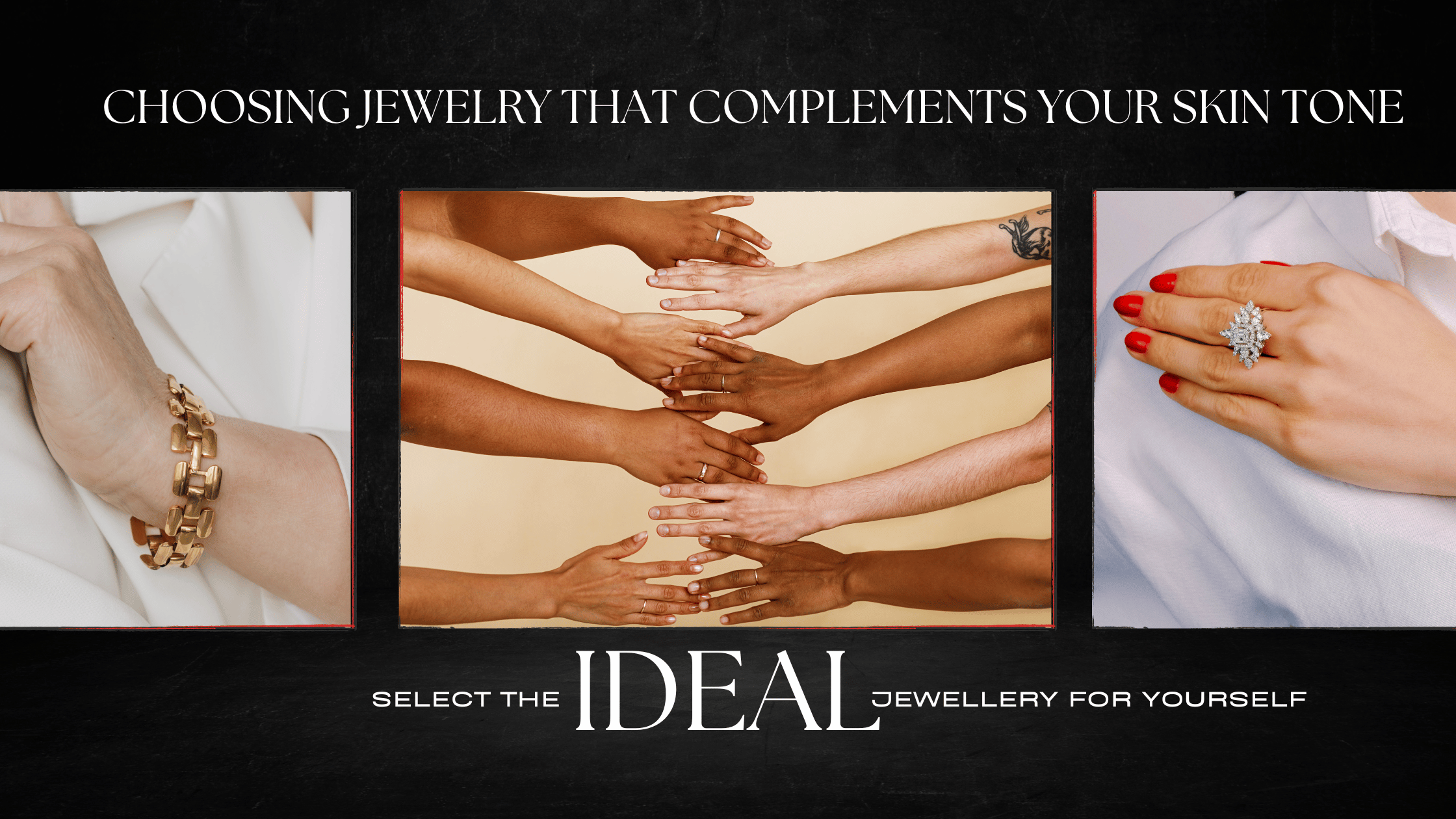Jewellery is more than just a fashion statement; it’s an extension of one’s personality. The right piece can elevate an outfit, express individuality, and even enhance natural beauty. However, not all jewellery is one-size-fits-all. Just as certain clothing colours can either flatter or clash with one’s complexion, the same holds for jewellery. Skin tone, often interchangeably used with complexion, refers to the apparent colour of one’s skin. It’s the shade you’d describe yourself as when selecting makeup or clothing colours. Factors like genetics, sun exposure, and certain skin conditions can influence skin tone.
In major cities like Kolkata, where there’s a rich tradition of jewellery-making, gold jewellers in Kolkata emphasize the importance of understanding this nuance. They craft pieces that not only dazzle but also harmonize with the wearer’s skin tone.
Understanding your skin tone and choosing jewellery that complements it can make all the difference in achieving a harmonious look.
Why Does Complexion Matter When Choosing Jewellery?
Your complexion plays a pivotal role in how certain metals and gemstones appear against your skin. The right jewellery can enhance your natural beauty, making your skin glow, while an ill-suited piece might make your skin look sallow or washed out. Just as you’d choose a dress colour to complement your skin, the same principle applies to jewellery.
Skin Tone vs. Undertone
Skin Tone is the surface colour of your skin, which can change depending on various factors like sun exposure or health conditions. While the undertone is the subtle, muted shade beneath your skin tone. Unlike the skin tone, your undertone remains consistent throughout your life.
Skin Tone Categories
- Light: This encompasses fair skin that often burns quickly in the sun and rarely tans.
- Medium: This includes skin that might burn initially but eventually tans to a golden hue.
- Dark: This category covers skin that tans deeply and rarely if ever, burns.
Undertone Categories
- Cool: Skin with bluish or rosy undertones. Silver jewellery often complements this undertone beautifully.
- Warm: Skin with golden, peachy, or apricot undertones. Gold jewellery, especially yellow and rose gold, tends to flatter this undertone.
- Neutral: A balanced mix of both cool and warm undertones. Neutral-toned individuals have the advantage of wearing both gold and silver jewellery with ease.
A Guide to Understanding Your Skin’s Hue and Undertone
Understanding the difference between skin tone and undertone is crucial when selecting jewellery, makeup, or even clothing. Here’s how you can determine yours:
The Vein Test:
- Roll up your sleeves and examine the veins on the underside of your wrist.
- If your veins appear predominantly blue or purple, you likely lean towards a cool undertone.
- If they seem more greenish, you’re in the warm undertone category.
- If you find it challenging to determine the colour or if your veins seem to be a mix of both blue and green, you probably have a neutral undertone.
The Jewelry Test:
- This is a fun and practical way to determine your undertone.
- Wear a piece of pure silver jewellery on one hand and a piece of pure gold jewellery on the other.
- Observe which metal makes your skin glow and appear more radiant. If silver is more flattering, you lean towards cool undertones. Conversely, if gold lights up your complexion, you have warm undertones.
The Sun’s Effect:
- How your skin reacts to the sun can also provide clues about your skin tone and undertone.
- If you burn quickly and rarely tan, you likely have a light skin tone with cool undertones.
- If you tan easily and rarely burn, you might have a medium to dark skin tone with warm undertones.
Selecting the Ideal Metal Hue to Match Your Complexion
Your complexion plays a pivotal role in how jewellery complements your overall appearance. The right metal can illuminate your skin, making it glow, while an ill-suited choice might make it appear dull or overshadowed. Here’s a comprehensive guide to help you select the perfect metal hue based on your complexion:
For Those with Cool Undertones:
- Metals to Opt For: The luminous sheen of metals like silver, platinum, and white gold beautifully complements the bluish undertones of cool skin. These metals reflect light in a way that enhances the natural coolness of the skin, making it appear more vibrant and radiant.
- Why It Works: Cool metals neutralize the pink or blue undertones, creating a harmonious balance that accentuates the skin’s natural beauty.
For Those with Warm Undertones:
- Metals to Embrace: The rich, warm hues of yellow gold, rose gold, and even copper are ideal choices. These metals have a warmth that mirrors the golden or peachy undertones of the skin, creating a synergy that’s both elegant and striking.
- Why It Works: Warm metals, with their golden undertones, enhance the skin’s natural warmth, making it glow with a sun-kissed radiance.
For Those with Neutral Undertones:
- Metals to Experiment With: Being blessed with neutral undertones means you can effortlessly oscillate between both cool and warm metals. Whether it’s the icy allure of silver or the timeless charm of gold, both can look equally stunning.
- Why It Works: Neutral undertones have a balanced mix of both cool and warm shades. This balance allows for versatility in jewellery choices, ensuring that most metals, whether cool or warm, will complement the skin.
Diamonds for Every Undertone
Diamonds, often referred to as a girl’s best friend, have an unparalleled allure that transcends the boundaries of skin undertones. Their universal appeal lies in their innate ability to reflect and refract light, casting a mesmerizing sparkle that complements every skin shade.
One of the primary reasons diamonds are universally flattering is their neutrality. Unlike coloured gemstones, which may favour certain undertones over others, diamonds remain unbiased. Their clear, colourless nature ensures that they don’t clash with or overpower any particular skin hue. Instead, they enhance the natural beauty of the wearer, adding a touch of elegance and sophistication.
Choosing the Right Diamond Setting
While diamonds themselves are neutral, the setting in which they are placed can play a significant role in complementing one’s skin tone.
- Gold Settings for Warm Undertones: Gold, with its rich and warm hue, beautifully complements those with warm undertones. When diamonds are set in gold, they borrow a bit of its warmth, resulting in a harmonious blend that accentuates the golden, peachy, or yellow hues of the skin.
- Silver or Platinum Settings for Cool Undertones: Silver and platinum, with their cool and sleek appearance, are the perfect match for those with cool undertones. Diamonds set in these metals reflect a cooler light, highlighting the bluish or pinkish tones of the skin, creating a balanced and radiant look.
The expertise of diamond jewellers is evident in their ability to craft exquisite pieces that cater to various skin tones. These jewellers, with their deep understanding of both diamonds and the diverse palette of human skin, create pieces that not only dazzle but also resonate with the individuality of the wearer. For those seeking personalized advice or custom pieces, consulting with jewellers in Kolkata or other major cities can provide insights into selecting the perfect diamond setting that aligns with one’s unique skin undertone.
Conclusion
Choosing jewellery that complements your skin tone is akin to selecting the right shade of makeup. It enhances, elevates, and brings out the best in you. Whether you’re drawn to the cool allure of silver or the timeless charm of gold, understanding your skin’s undertones can guide you in making choices that resonate with your unique beauty. Remember, while guidelines can help, personal preference and individual style always reign supreme. So, the next time you’re out jewellery shopping, let your skin tone guide you but let your heart make the final decision.


